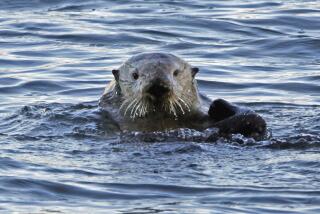After 50 Years, R.I. Oysters May Be Making a Comeback
- Share via
PROVIDENCE, R.I. — Rhode Island oysters--as famous as Maine lobsters until pollution and overfishing wiped them out during World War II--may be making a comeback.
The numbers are tiny as yet, but shellfish dealers report buying occasional batches of oysters from fishermen who normally harvest quahogs, or hard-shell clams.
“There are quite a bit of oysters around,” said Mark Boucher, manager of Top Quality Shellfish in Bristol. “Two, three years ago, you wouldn’t see anybody digging them.”
But some Rhode Island oyster beds remain off limits because of pollution.
“The largest oyster population is in the Pawcatuck River, which has been closed (to shellfishing) for years,” said Arthur Ganz, senior marine biologist with the state Department of Environmental Management.
To assess the extent of the comeback, the Narragansett Bay Project next month will start an 18-month study to pinpoint the bay’s oyster beds.
“The speculation now is that they are remnants of the cultivated oyster industry that was flourishing here in 1900 to 1940,” said Caroline Karp, the project’s director.
Michael Rice, assistant professor of fisheries at the University of Rhode Island, said the drop in metal pollution in the upper bay in the last few years might be one explanation for the oyster revival. Adult oysters can live in extremely polluted waters, but metal contamination can be fatal to oyster larvae.
Metal pollution at the Narragansett Bay Commission’s sewage treatment plant in Providence dropped from 954,000 pounds per year in 1981 to 180,500 pounds per year in 1988, said Chip Young, spokesman for the environmental group Save the Bay.
Parts of the bay that are distant from the plant are open to shellfishing.
The oyster industry flourished in Narragansett Bay in the early part of the century. Because oysters spawn best in comparatively fresh water but grow best in saltier water, the baby bivalves were imported into the bay.
“The oysters were dredged from coves in Connecticut, schoonered over to Narragansett Bay and left to grow until they were big and fat and succulent,” Ganz said.
“The old discarded shells would be shoveled back on the schooners, sent back to Connecticut and used as cultch,” the ragged surface that young oysters need to attach themselves to in order to grow.
Rhode Island oysters in those days were known as the best in the country, smaller but less salty than those raised in the Chesapeake Bay, Rice said.
“They had a mystique about them, something like the Maine lobsters,” Rice said.
Increasing pollution and the destruction of reefs by silt and over-use of oyster tongs wiped out the oysters around World War II, and many shellfishermen turned to quahogs that recently have become a Rhode Island state symbol, Rice said.
Ironically, a shortage of quahogs may be helping fuel the renewed interest in oystering, Boucher said.
“They are digging them now more so because of the shortage of littlenecks,” he said. “The upper bay isn’t open as much anymore (to quahogging), so they’re looking for any other way to make a dollar.”
Oysters bring anywhere from 70 cents to $1.20 a pound at Rhode Island docks, about the same price as steamer clams but less than the prized littlenecks, the smallest and most tender of the quahogs.
More to Read
Sign up for Essential California
The most important California stories and recommendations in your inbox every morning.
You may occasionally receive promotional content from the Los Angeles Times.










